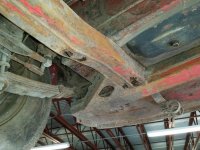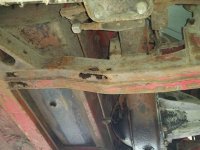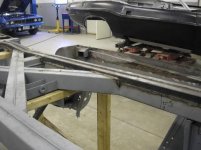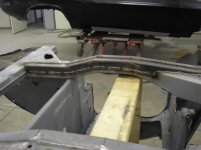I'll try to keep this short, but I'm soliciting opinions on where to go with this.
This is a late production '67 BJ8. I bought it from the original owner about 35 years ago (IIRC).
I only drove it for a year or so, and then life happened and it's been in inside warehouse storage since then.
It's 100% original (but needing much restoration) and with about 42k original miles. I'm only now, in my retirement years, about to jump in with the resto.
Take a look at the two pics here, and I'll point out that while most of the frame paint is peeling off and there is obvious surface rust, the frame is really in great shape EXCEPT for just the area I show in these two pictures which are of the same area but from two different angles.
I hate to think of replacing the complete frame because it really IS in great shape overall, but as you can see, the last couple of feet of the rear of the right main frame rail has some rust-through spots.
I'll also mention that I'm replacing the original rocker panels as well (for rust), but all of the rest of the car looks pretty good and really only needs lots of TLC stripping, some sandblasting, and epoxy priming.
I may or may not have personal opinions on where to go with this, but I want to hold back on my ideas and get some suggestions from the herd here in the Forum so I can come up with a plan.
So for those who feel that they've "been there, done that" with regard to handling rust issues, I present you these pics.
What do you think, guys?
This is a late production '67 BJ8. I bought it from the original owner about 35 years ago (IIRC).
I only drove it for a year or so, and then life happened and it's been in inside warehouse storage since then.
It's 100% original (but needing much restoration) and with about 42k original miles. I'm only now, in my retirement years, about to jump in with the resto.
Take a look at the two pics here, and I'll point out that while most of the frame paint is peeling off and there is obvious surface rust, the frame is really in great shape EXCEPT for just the area I show in these two pictures which are of the same area but from two different angles.
I hate to think of replacing the complete frame because it really IS in great shape overall, but as you can see, the last couple of feet of the rear of the right main frame rail has some rust-through spots.
I'll also mention that I'm replacing the original rocker panels as well (for rust), but all of the rest of the car looks pretty good and really only needs lots of TLC stripping, some sandblasting, and epoxy priming.
I may or may not have personal opinions on where to go with this, but I want to hold back on my ideas and get some suggestions from the herd here in the Forum so I can come up with a plan.
So for those who feel that they've "been there, done that" with regard to handling rust issues, I present you these pics.
What do you think, guys?

 Hi Guest!
Hi Guest!

 smilie in place of the real @
smilie in place of the real @
 Pretty Please - add it to our Events forum(s) and add to the calendar! >>
Pretty Please - add it to our Events forum(s) and add to the calendar! >> 





